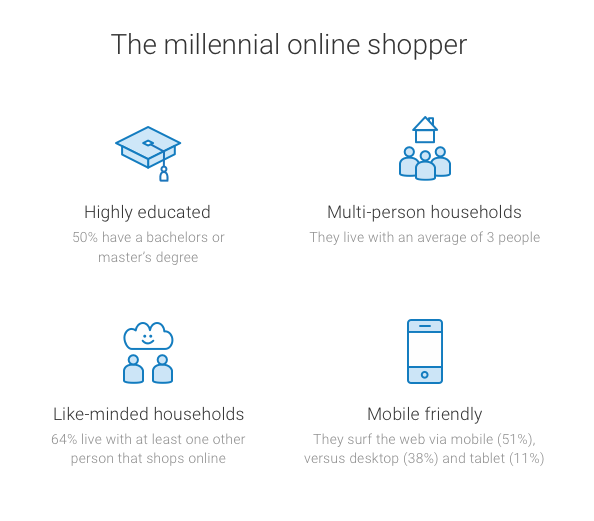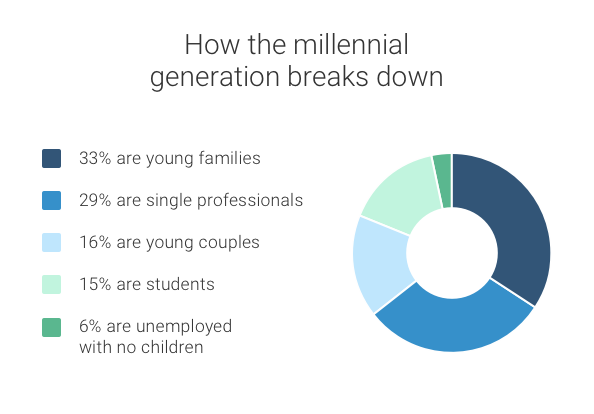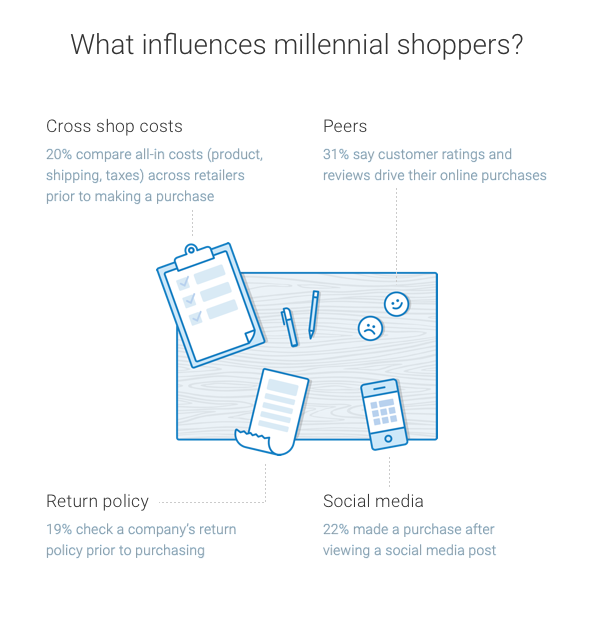
Looking to attract the Canadian millennial shopper? Get to know them first.
Nearly every retailer today is making millennials — the first truly digital generation born between 1982 and 2000 — their priority, working hard to understand what interests, drives and delights this influential group.
It’s no easy task. The rise of mobile has meant that they can stay connected wherever they happen to be, and retail strategies have had to adapt to this. Nonetheless, Generation Y represents an amazing opportunity for smart retailers to gain and increase market share.
Interested in reading more from Canada Post? Visit the Canada Post Shipping Solutions Blog for more articles to help you operate your e-commerce business more effectively.
READ ALSO: The anatomy of Canada’s hyper shopper
With 80% of Canadians now shopping online and millennials accounting for 33% of all online purchases in Canada, it’s vital that e-commerce retailers in particular understand what drives this group’s buying patterns.
Whether by rocking your mobile marketing or targeting social groups instead of life stages, you can definitely make inroads with this important demographic. New, market-leading research from Canada Post can help by providing an in-depth look at this segment of shoppers and why they represent such a pivotal opportunity for future e-commerce market growth.
Changing the face of shopping
The most diverse generation to have ever existed, today’s millennials include increasingly affluent adults in their 20s and 30s. Many are building careers, raising kids, and living in their own homes – which means their collective spending is expected to rival, if not exceed, all other demographics.
Millennials already make up 35% of hyper shoppers, making at least 25 purchases per year, and that number is expected to increase sharply.
Here’s what Canada’s millennial shoppers look like and why they’re deserving of your attention

Different clusters with varying needs
Not all millennials are the same, of course. In fact this group is made up of a few key sub-segments:
 Needless to say each of these categories of millennials has different needs and wants when it comes to online shopping – whether it’s the product categories they purchase or their expectations for how quickly their orders arrive.
Needless to say each of these categories of millennials has different needs and wants when it comes to online shopping – whether it’s the product categories they purchase or their expectations for how quickly their orders arrive.
You’ll want to segment the population and drill down to the exact ideal buyer you’re targeting, providing these prospective buyers with the experiences they require.
Digital, connected, and demanding
Millennials are particularly adept at using different mobile devices, apps and social media in search of their purchases (20% regularly compare costs across an array of merchants) and they expect an integrated, seamless experience, regardless of the channel, upon arrival.
Each channel must support the others in ways that drive engagement, and are, in combination, easy and straightforward to use.
Amazon, for example, is an industry leader because it does a great job at finding and minimizing any type of friction. From Amazon Prime to free shipping and one-click ordering, its innovations are centred on removing barriers that might impede customers.
Given millennials’ fondness for sharing their experiences publicly, user-generated content is another key driver in their decision-making process. Millennials talk openly about what they like and don’t like, and share their opinions widely with friends and family.
That’s why it’s important to leverage social media (31% of millennials check rating and reviews before buying) with this group whenever you can. Once they commit, they can quickly become spokespeople for your company.
Bad news travels equally fast though. Thirty-four percent of millennials, for instance, say a poor delivery experience would stop them from shopping with that retailer again.
Here are some of the things that drive Canada’s millennial shoppers.
A growing e-commerce force in Canada
Digitally savvy, millennials use technology to hedge their bets. They spend a lot of time researching products, regularly searching out reviews and user feedback – increasingly through mobile devices.
Millennials’ increasingly sophisticated shopping habits are being passed on to older generations as well, fuelling a sustained period of online sales growth – another reason you need them on your side.
Like what you’ve read? Click here to check out the original post and other related articles
For more insight on identifying and attracting these important shoppers to your business, get our latest whitepaper on growing e-commerce in Canada.
Source: eMarketer report, Nov, 30 2015. Originally obtained from “Ipsos Canadian Inter@ctive Trends Report” as cited in press release Nov. 30, 2015. Study done in June 2015 based on past 12-month activity.
READ MORE: E-commerce returns: from costly complication to competitive advantage

